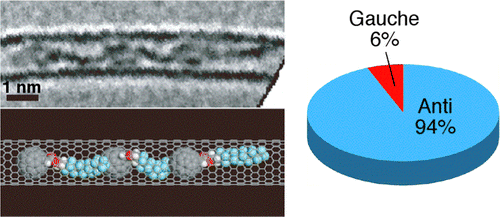Harano, K.; Takenaga, S.; Okada, S.; Niimi, Y.; Yoshikai, N.; Isobe, H.; Suenaga, K.; Kataura, H.; Koshino, M.; Nakamura, E. J. Am. Chem. Soc. 2013, ASAP
DOI: 10.1021/ja411235x
Whereas a statistical average of molecular ensembles has been the conventional source of information on molecular structures, atomic resolution movies of single organic molecules obtained by single-molecule real-time transmission electron microscopy have recently emerged as a new tool to study the time evolution of the structures of individual molecules. The present work describes a proof-of-principle study of the determination of the conformation of each C–C bond in single perfluoroalkyl fullerene molecules encapsulated in a single-walled carbon nanotube (CNT) as well as those attached to the outer surface of a carbon nanohorn (CNH). Analysis of 82 individual molecules in CNTs under a 120 kV electron beam indicated that 6% of the CF2–CF2 bonds and about 20% of the CH2–CH2 bonds in the corresponding hydrocarbon analogue are in the gauche conformation. This comparison qualitatively matches the known conformational data based on time- and molecular-average as determined for ensembles. The transmission electron microscopy images also showed that the molecules entered the CNTs predominantly in one orientation. The molecules attached on a CNH surface moved more freely and exhibited more diverse conformation than those in a CNT, suggesting the potential applicability of this method for the determination of the dynamic shape of flexible molecules and of detailed conformations. We observed little sign of any decomposition of the specimen molecules, at least up to 107 e·nm–2 (electrons/nm2) at 120 kV acceleration voltage. Decomposition of CNHs under irradiation with a 300 kV electron beam was suppressed by cooling to 77 K, suggesting that the decomposition is a chemical process. Several lines of evidence suggest that the graphitic substrate and the attached molecules are very cold.
An isolated molecule has been an “imaginary entity” that can only be studied theoretically, since the most of common analytical methods such as NMR, IR, X-ray analysis give us an averaged picture of vast molecules. In 2007, Nakamura group, University of Tokyo, are challenging the imaging of small organic molecules with the aid of high-resolution transmission electron microscope (TEM) (Science, 2007, 316, 853. DOI:10.1126/science.1138690).
The high-performance TEM (single-molecule real-time TEM: SMRT-TEM)enables them to directly observe various motions (conformational change, rotation, and translation) of individual molecules.
In this paper, they visually determined the anti/gauche ratio of all C−C bonds in each molecule of perfluoroalkyl fullerene and study the overall shape of the moving molecules by using SMART-TEM.
[amazonjs asin=”3642297609″ locale=”US” title=”Transmission Electron Microscopy and Diffractometry of Materials (Graduate Texts in Physics)”][amazonjs asin=”0387765026″ locale=”US” title=”Transmission Electron Microscopy: A Textbook for Materials Science (4 Vol set)”]


